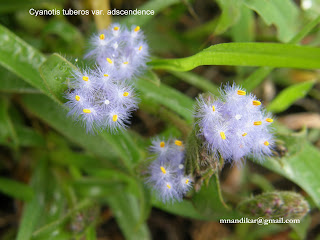Murdannia nimmoniana and Commelina diffusa
Few persons Know
this word Commelinaceae
But student belongs to Botany Especially Taxonomy are very familier with this one.
Commelinaceae R.Br. is wide spread family all over the world, and Morphotaxonomical studies includes morphological, cytological, palynological, anatomical and embryological description.
Commelinaceae is most interesting family belonging to Commelinales. Commelinales consist of 4 families and nearly 1000 species i.e. Commelinaceae 700 species and Xyridaceae 270 species together make up the bulk of the order, Rapataceae have about 80 species and the Mayaceae represented only four (Cronquist in 1981).
Family Commelinaceae as defined by Cronquist (1981) of about 50 genera and 700 species, wide spread in tropical and sub-tropical regions. Wide spread genus like Floscopa, Aneilema, and Commelina are found distributed throughout the tropical belt. Genera like Pollia, Cyanotis, and Forrestia are found in tropical zone of Asia and Africa, while Palisota, Buforrtia, Coleiotrype, Anthericopsis and Polysphatha are found in tropical Africa. About 16 genera are found restricted to tropical America. Sphatholirion is distributed in Malayan region and western part of China, remarkable for its inflorescence with the base of sheath. Occur in west Africa Guiana’s, similarly Coleiotrype, with inflorescence per forting leaf sheath, occurs in East Africa and Island of Madagascar.
The Family Commelinaceae is represented in India by about 14 genera and 85 species (Karthikeyan, S. & S. K. Jain Flora of India in 1989.). They include Aneilema (24sp.), Commelina (20sp.), Cyanotis (16sp.), Pollia (5sp.), Forrestia (5sp.), Floscopa (15sp.), and Streptolirion (1sp.). Streptolirion volubile Edgew a climbing member of family restricted to Himalayan region, including North East Khasia and Jaintia hills of Assam growing altitude of 5000 to 9000 feet the other genera are distributed throught the country. In Maharashtra by about 10 genera and 51 species (Sharma,B.D., S. Karthikeyan and N.P. Singh, Flora of Maharashtra state in 1996, BSI) well distributed allover the state (most of the species found in Sindhudurg, Kolhapur and Satara districts). The morphology of family is very interesting, and shows great diversity in their floral structure; however its forms very natural assemblage of well defined genera and their interrelationship are still controversial.
Among the monocotyledon family Commelinaceae is found to be very ideal plant material for cytological work. Extensive cytological work has been done on some genera like Tradescantia, Setcresea, Commelina, Cyanotis, etc.
Although most of the members of Family Commelinaceae grow as weeds, some of them are have ornamental value. The ornamentals includes Zebrina pendula Schhizi., the ’Wondering Jew’ is a common house plant. Rhoes spathacea Swartz is often cultivated as edge plant, and Tradescantia, spiderwort are used as an garden ornamentals.
PLANT CHECKLIST
Commelinaceae members found in Maharashtra.(Shrama, B.D., S.Karthikeyan and N.P. Singh, Flora of Maharashtra state in 1996, BSI) are listed below----------------------------------------------------------------------------------------
Belosynapsis vivipara ( Dalz.) Sprague ex C. E. C. Cyanotis vivipera Dalz.
Vulnerable in Konkan
Fls n Frts Aug to Sept. Ephiphytic
Commelina suffruticosa Bl.
C. attenuata Vahl
Akola, Amravati, Bhandara, Chandrapur, pune, Vardha Aug to Nov
C. benghalensis L
C. clavata Cl.
Rare in Hilly forests. Raigad sept- oct
C.erecta L. C. undullata
Common in all districts Aug to Oct
C. diffusa Burm. f.
Gandolgi all over the Maharashtra July to Feb
C. forsskalaei Vahl
Canpet Common July to Dec.
C. hasskarilii Cl.
Common June to March
C. hirsuta Cl.
rare Nashik July to November
C. kotschyi Hassk.
Rare grvelly and sandy river beds Nashik ; Pune Sept to Oct.
C. longifolia Lam.C. salicifolia
Konkan, pune Cultivated in Gardens Oct to dec.
C. maculata Edgew.
Common Aug to Nov
C. paleata Hassk.
Mumbai, Pune, Konkan, Ahemadnagar July to September
C. subulata Roth
Kolhapur, Pune July to October
C. suffruticosa Bl.
Common July to Oct
Diubtful and indeterminable species
C. avenaefolia Grah.
In dense part of Khandala
Cultivated species
C. virginica L.
Rolla Rao in Blumea 14: 354. 1966 Cultivated in Gardens An American Species
Cyanotis arcotensis Rolla Rao in Blumea 14: 345,f.1. 1996
Fls n frts October Pune
C. cerifolia Rolla Rao & Kammathy in J. Linn. Soc. Bot. 59(379):306, f. 1-6. 1966 Aug to Nov. Pune
C. concanensis Hassk. C. sahydrica
July to Nov. Common
C. cristata (L.) D. Don,
June to Nov. Common
C. fasiculata var. fasiculata (Heyne ex Roth)
C. fasiculata var. glabrescens C. B. Cl.
C. obtusa Trim.
C. papilionacea var. papilionacea (L.) R.& S.
Konkan Aug to September
C. papilionacae var. vaginata (Wight) C. E. C. Fischer
rare in wet places Sindhudurg Aug to oct
C. pilosa Scult.
Rare in wet grounds Satara Aug to September
C. tuberosa var. tuberosa (Roxb.) J. A. & J. H.
Common June to Oct.
C. tuberosa var. adscendens (Dalz.) C. B. Cl.
Common June to Oct.
Floscopa scandens Lour.
In Marshes Satara, Sindhudurg Sept to Oct.
Murdania vaginata (L.)Brueck.
Bhandara, Mumbai, Kolhapur Aug to Oct
M. lanuginosea (Wall. Ex C. B. Cl.)
Kop. Satara, Sindhudurg May to Oct
M. crocea (Griff.) Faden ssp.Ochracea (Hassk.) Faden
Raigad Ratnagiri Satara October
M.dimorpha (Dalz.) Brueck.
Satara Raigad Ratnagiri Pune Aug to sept.
M.edulis (Stokes) Faden
Mumbai, Chandrapur May to june
M.gigentea (Vahl) Brueck
Kolhapur ratanagiri, Aug to dec.
M. japonica (Thunb.) Faden
Sindhudurg Aug to Oct
M. lanceolata (Wight) Kammathy
Konkan
M. loriformis (Hassk.) Rolla Rao & Kammathy
Kop. Aug- Oct
M. nudiflora (L.) Brenan
Common July to Nov.
M. semisteres (Dalz.) Sant
Common July to Oct.
M. simplex (Vahl) Brenan.
Common May to Oct
M. spirata (L.) Brueck.
Nagpur, Mumbai, Kolhapur July to Feb
M. versicolor (Dalz.) Brueck
Common AUG TO Nov
M. waghtii Rolla Rao & Kammathy
Ratnagiri, satara Oct.
Pollia subumbellata C. B. Cl.
Satara Sept
Tonningia axillaris (L.) O. Ktze.
Common July to Dec
T. cucullata (Roth) O. Ktze.
Common July to Dec.
CULTIVATED SPECIES
Rhoeo spathacea (Swartz) Stearn
Common in Gardens Anative of Central America
Setcreasea purpurea Boom
It’s a native of Mexico and is Called’ purple heart’ becoz of the striking purple colour of this plant in strong sun.
Zebrina pendula Schnizl
It’s a native of mexico



